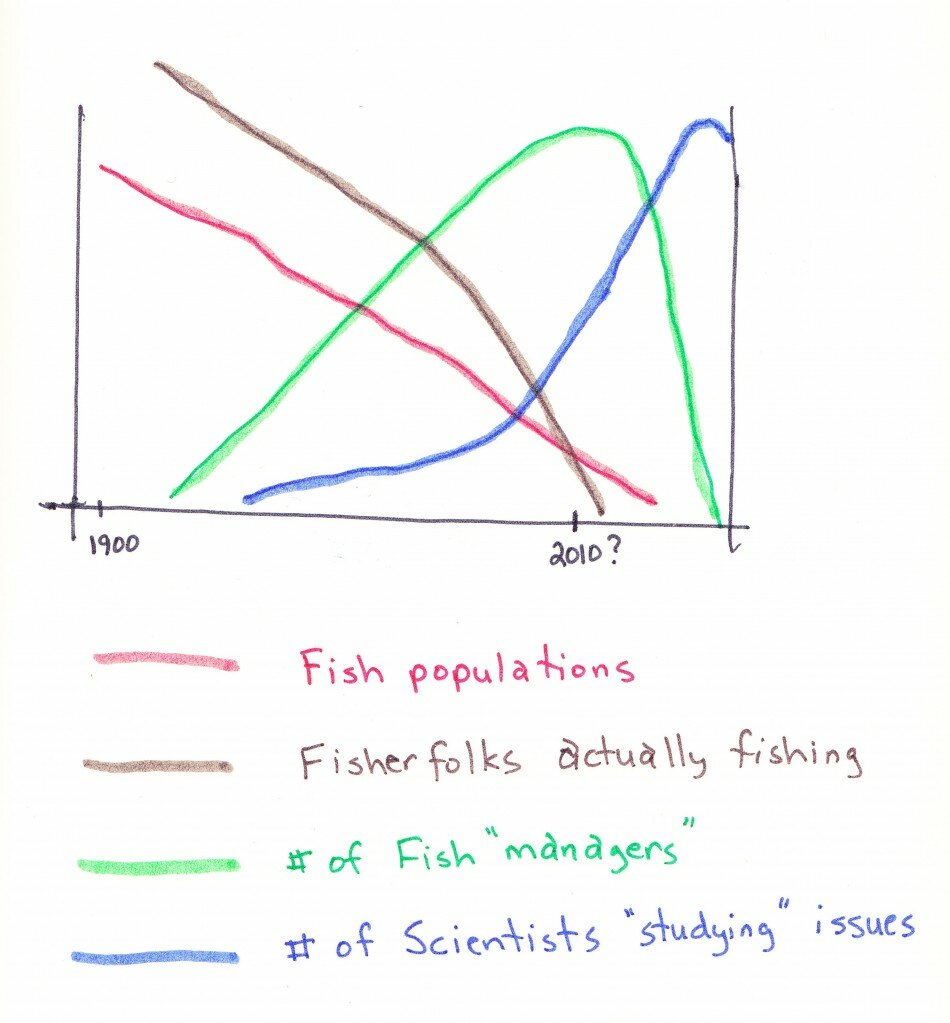This is my graphic representation of fish populations (e.g. wild salmon) that have been industrially exploited…
I suppose there’s one line missing on this graph, a relatively flat steady line running across the last half of the time series that represents the number of politicians responsible for these issues. (however, then we would need to graph their salaries – e.g. MP earns base salary of around $150,000 plus Ministers can earn another $70,000 or so, on top of that)
There’s an article related to this idea by Jeffrey Simpson in the Globe and Mail today —
A very bad movie has returned to Newfoundland. The script is well-known; the actors have not changed; the plot never alters; and the commercial results are always disappointing. Yet the movie keeps coming back for another rendition.
The plot revolves around what used to be a mainstay industry for Newfoundland: the cod fishery. It has been in decline for decades, during which scientific advice about the precariousness of the cod stocks was usually ignored.
There were too many parties, and too many politicians, with vested interests in ignoring science, or playing it down, or claiming that the results were biased. They are still around, and vocal.
Cue the current reel of the old movie. Once again, scientists from the Department of Fisheries and Oceans are providing the data on which the Committee on the Status of Endangered Wildlife in Canada makes recommendations to the federal government. Once again, the committee has recommended that Atlantic cod be designated an endangered species. And once again, all the usual suspects are dumping on the science, discrediting the recommendation of the scientists.
Fishermen are irate. The provincial Fisheries Minister says stocks are improving, thereby justifying the existing levels of fishing. And the Fish, Food and Allied Workers Union calls the committee report “political science,” “misleading,” and “nonsense.”…
We’re well along the way of writing a similar story for Pacific salmon here on the west coast…
Dalhousie University fisheries biologist Jeff Hutchings [suggests]…northern cod stocks are 4 per cent of their levels of the 1960s and 10 per cent of their 1980s levels… The replacement rate of cod is far less than half of what would be required just to maintain the stock at existing levels.
Hmmmm….
Have you seen my hand drawn graph for Fraser River sockeye? (yeah that’s over 160 million in the 1800s to about 1 million last year):
 And the replacement rate (productivity) — from the “ of early December 2009:
And the replacement rate (productivity) — from the “ of early December 2009:
A rate of less than 2 adult returns per spawner means that runs are not even replacing themselves. Two (one male, one female ideally) per reproductive adult is the bare minimum for any population of anything to maintain itself.
Here’s my “favorite” part (as in sad) of Simpson’s article:
In the United States, legislation mandates the federal government to regulate fishing of [cod] stocks at the level of long-term renewal, rather than seeing them depleted and then perhaps built up later. In Canada, no such legislation exists. There are no targets or rebuilding strategies, just a series of one-off, yearly assessments ultimately left in the all-powerful hands of the federal minister of fisheries.
…Long-term stock recovery gives way almost every time to short-term job and profit considerations. When Ms. Shea responded to the endangered-wildlife committee’s report by saying she would “study it,” we know what will come next. Nothing.
And if you aren’t familiar with Ms. Shea, the current federal Fisheries Minister she had a long illustrious career with Revenue Canada before being elected a Conservative Member of Parliament (MP) for PEI.
Revenue Canada… fish science… revenue canada… fish science…. hmmm.
And let me know if you’ve seen Fisheries and Ocean’s Canada (DFO’s) long-term rebuilding plan for Fraser Sockeye… uh, yeah… it’s called air pie. (if you haven’t heard about air pie… growing up in our household, it was our least favorite answer to: “what’s for desert” —- “air pie”.)
Oh no… wait… we are “studying” that too — it’s called the $15-$20 million . At least the studying has become a whole lot easier as there were only 1 million last year as opposed to well over 100 million a little over 100 years ago.
My hope is that the Cohen Commission doesn’t become “air pie” — like the $5 million British Columbia Pacific Salmon Forum for example, or, the multitude of other public inquiries into salmon that were not acted upon…

 The pot that’s filled to the brim is like a mind full opinions and preconceptions. We already know it all. We have so many fixed ideas that nothing new can affect us or cause us to question our assumptions.
The pot that’s filled to the brim is like a mind full opinions and preconceptions. We already know it all. We have so many fixed ideas that nothing new can affect us or cause us to question our assumptions.








 Today I drove south along the coast to Cannon Beach, Oregon and then east inland to Portland. It’s quite remarkable how many “salmon hatcheries” I’ve driven by. Yet… looking up to the hillsides it’s not that difficult to see one of the big reasons why so many hatcheries may be required.
Today I drove south along the coast to Cannon Beach, Oregon and then east inland to Portland. It’s quite remarkable how many “salmon hatcheries” I’ve driven by. Yet… looking up to the hillsides it’s not that difficult to see one of the big reasons why so many hatcheries may be required.